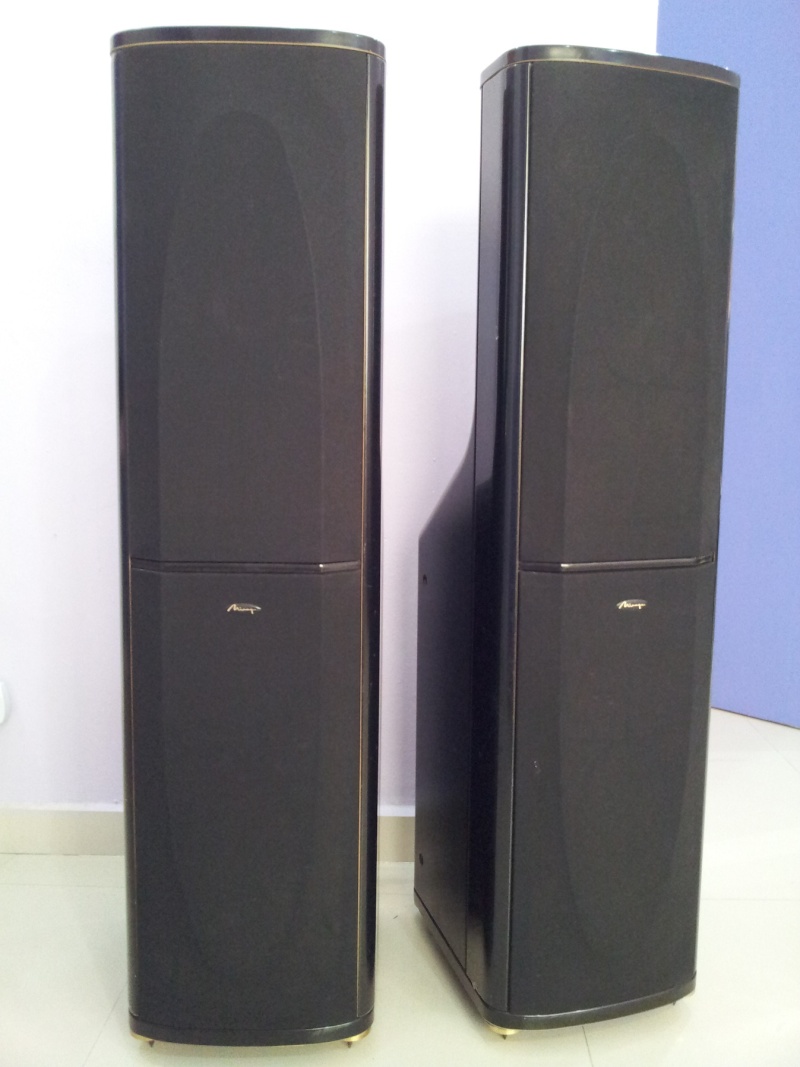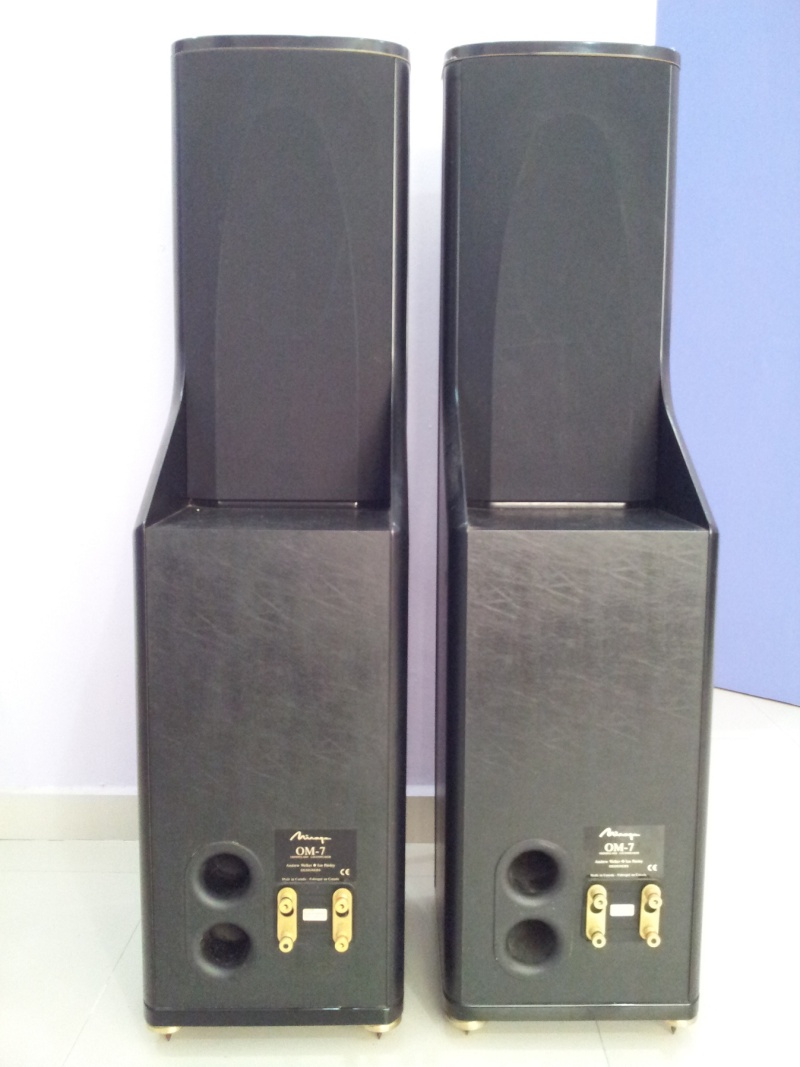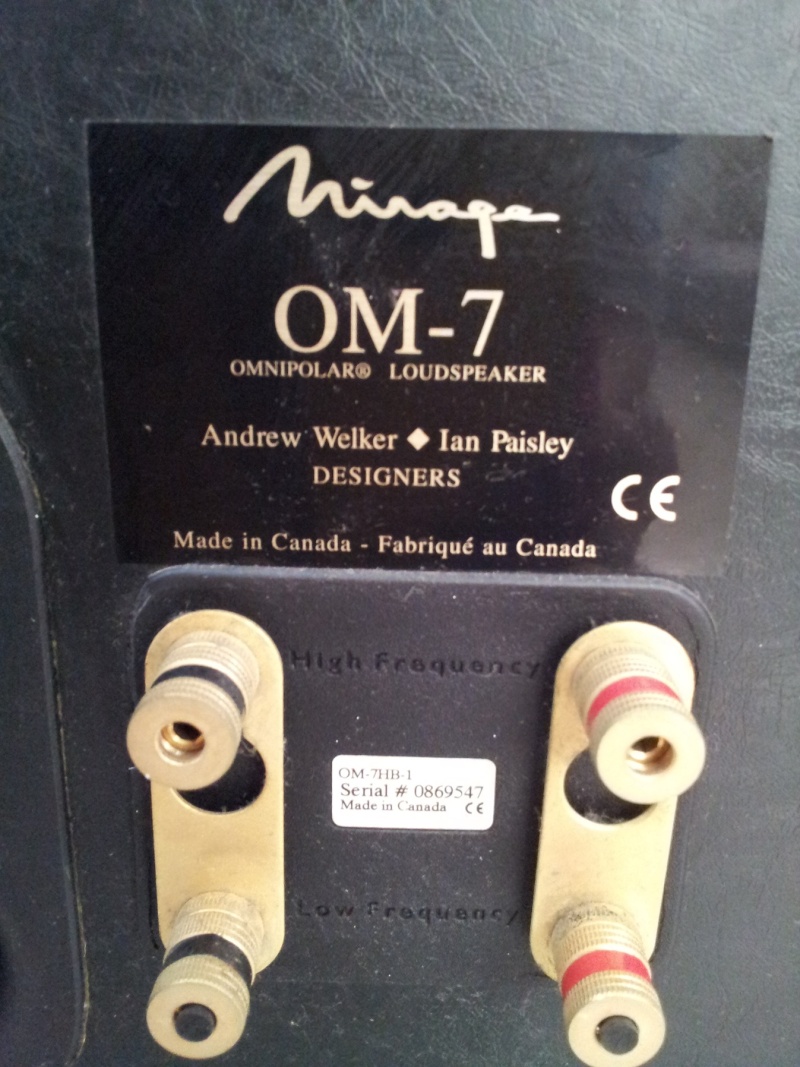Mirage Omnipolar Loudspeakers OM-7 Floorstanding Speakers ( Used)
Hi-Fi 4 Sale - Malaysia / Singapore Audio Forum & Marketplace | www.hifi4sale.net :: Audio & Video Equipment Marketplace :: Audio & Video Equipment: FOR SALE (Pre-owned & Used)
Page 1 of 1
 Mirage Omnipolar Loudspeakers OM-7 Floorstanding Speakers ( Used)
Mirage Omnipolar Loudspeakers OM-7 Floorstanding Speakers ( Used)





Made In Canada
Audiophile Quality and Solid Built.
Description:
Floorstanding, reflex-loaded, "Omnipolar" loudspeaker.
Drive-units: two 1" PTH-cone (Pure Titanium Hybrid) tweeters,
two 4.5" polypropylene-cone midranges with butyl surrounds,
one 8" polypropylene-cone woofer with butyl surround.
Tweeters and midranges arranged in Omnipolar array (one of each pair fires forward, one rearward).
Crossover frequencies: 200Hz, 2kHz.
Frequency response: 30Hz-20kHz, +/-3dB.
Room efficiency: 90dB.
Impedance: 6 ohms nominal,
4 ohms minimum.
Recommended amplifier power: 50-200W.
Dimensions: 43.75" H by 11.5" W by 14.4" D. Weight: 78 lbs each.
Finishes:high-gloss black
Mirage is a good name for a speaker manufacturer;
it suggests that their products produce realistic illusions.
A 1934 dictionary I've got supplies a definition for "mirage" that might also be apt:
"An optical atmospheric illusion by which the image of a distant object is seen as if inverted."
I don't mean that the Mirage OM stands Harry Belafonte on his head, or make him sing "O-Day"—instead,
certain tenets of cones-in-a-box loudspeaker design and usage are turned turvy-topsy by Mirage's Omnipolar concept
( Something that the Ohm Walsh speakers have been doing for many years, and, more recently, certain models from MBL—both with designs very different from that used by Mirage. This is also something that Bose tried to achieve with the original 901)
History, theory, and such
In 1987, Mirage debuted the M-1—the first "bipolar" speaker design. What chief designer Ian Paisley did was put conventional drivers on the back as well as the front of the cabinet, and drive them in phase—unlike a dipole speaker, in which the front and back waves are out of phase. The goal, then as now, was to produce a truly omnidirectional radiation pattern—as if the sound was being produced from something like a pulsating ball (it's actually more like a vertical cylinder)
Obviously, room reflections will play a big part in the perceived sound of such a speaker; this, too, is part of the design desiderata. Mirage believes that the combination of direct and reflected sound, when produced by a truly omnidirectional radiator, sounds more like live music than what can be achieved by forward-firing designs or dipolar loudspeakers, and that the senses of depth and space will be very convincing. Imaging with omnidirectional speakers won't be as vividly precise as with conventional speakers; however, Mirage contends that such hyper-detailed imaging isn't natural or (therefore) desirable.
Mirage's M-series speakers, though quite well-received, didn't completely achieve Paisley's omnidirectional ideal. The problem was that output at 90 degrees off-axis—that is, directly to the side of the cabinet—was somewhat reduced, resulting in a figure-8 dispersion pattern.
The OM series was designed to solve this problem, primarily by moving the front and rear baffles as close together as possible, and by careful design of all other parameters: baffle width, shape of the edge and interface with the grille to make positive use of diffraction effects, selection of drivers and crossover frequencies, etc. The result, as Mirage suggests in the "Technical Overview" document packed with the speakers, is that you can put your nose on the side of the cabinet and it'll sound as if you're listening to a driver that's right in front of you. This is true (I tried it) and not very surprising: you've got a set of drivers right in front of each ear, albeit facing the same direction as your ears instead of at them. It's stereo imaging! However, as you might expect, at this position the highs are somewhat rolled-off. No one said that obtaining purely omnidirectional behavior would be easy.
Audiophiles who've spent significant time and money to damp or diffuse the first-reflection points on the side walls of their listening rooms need to undo their work to listen to the OM-7 as intended. For Mirage, we rewrite the well-known audiophile axiom of "Side-wall reflections bad!" to "Side-wall reflections good!"
Conclusion
The Mirage OM-7 is a unique speaker, the result of a quest to perfect a technology conceived more than 15 years ago. It would appear that, in engineering terms, Mirage has succeeded. The OM-7 is also a lot of speaker for the money—for five drivers,
a large, solid, floorstanding cabinet, and substantial biwirable binding posts.
As for musical enjoyment, that's in the ear of the beholder. There is no more highly variable family of components than the loudspeaker clan. Digital vs analog, tubes vs solid-state, and push-pull vs single-ended are high-profile religious debates, but at least the lines are well-drawn. With loudspeakers, there are almost as many conceptual camps as there are audiophiles. With which should one align?
Is your calling awaiting you in the Order of the Omnipolar? Depends. If you're a PIF (Precision Imaging Freak), then probably not—the OM-7s image surprisingly well, but not in that hyperreal way that can be so spooky (if unreal). Also, he who lives in a glass house shouldn't throw down long green for omnidirectional speakers; in fact, in an environment that reflective you'd do well to consider forgoing all speakers and switching to headphones.
But if you've got a room that can handle deep bass and isn't too lively, and you like a more natural, relaxed take on the stereophonic imaging thing, then the OM-7 is definitely worth a listen. It may be just what you were looking for but didn't know it—because an Omnipolar speaker's like virtually nothing else.
Review for reference:
http://www.audioreview.com/cat/speakers/floorstanding-speakers/mirage-loudspeakers/om-7/prd_124622_1594crx.aspx
http://www.audioenz.co.nz/2000/12/mirage-om-7/
http://www.soundstage.com/revequip/mirage_om7.htm
http://www.audio-ideas.com/reviews/loudspeakers/mirage-om7.html
Elegant High Gross Piano Finishing
Price : RM 5800
Contact Simon Ting 012-3612507
HiFiLab- Dealer\Reseller\Trader\Service Provider

- Number of posts : 2967
Age : 44
Location : klang
Registration date : 2011-03-12
Character sheet
Source(s):
Amplification:
Speakers:
 Similar topics
Similar topics» Mirage Canada OMNI 260 2.5 ways Omnipolar Floorstanding Speaker
» Mirage MX 5.1 Omnipolar
» Mirage omnipolar metal spk stand
» Mirage OM9 Floorstanding speakers used
» Mirage OMD 15 floorstanding speakers- SOLD
» Mirage MX 5.1 Omnipolar
» Mirage omnipolar metal spk stand
» Mirage OM9 Floorstanding speakers used
» Mirage OMD 15 floorstanding speakers- SOLD
Hi-Fi 4 Sale - Malaysia / Singapore Audio Forum & Marketplace | www.hifi4sale.net :: Audio & Video Equipment Marketplace :: Audio & Video Equipment: FOR SALE (Pre-owned & Used)
Page 1 of 1
Permissions in this forum:
You cannot reply to topics in this forum








